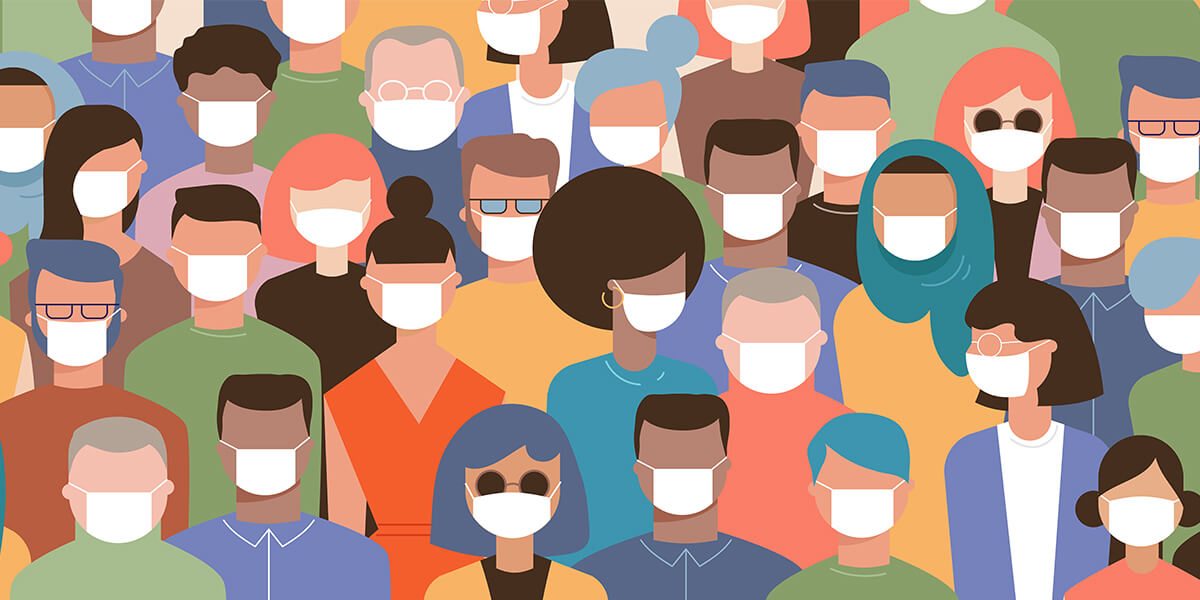
USC researchers simulated the spread of COVID-19 on a university campus, specifically by modeling airborne transmission risks associated with in-person classes. Photo/iStock.
With coronavirus cases rising again in nearly every US state, the big question is: how can we stay safe while resuming normal life, particularly in crowded spaces such as college campuses? Over the past two years, decision-makers have been forced to make choices about everything from vaccination and mask mandates to occupancy limits, based on ever-changing assumptions about COVID-19.
Now, USC researchers have helped quantify the effectiveness of some of the most debated mitigation strategies by simulating the spread of COVID-19 on a university campus, specifically modeling airborne transmission risks associated with in-person classes.
The new study, published in the Proceedings of the National Academy of Sciences (PNAS), shows that during the highly transmissible Delta variant outbreak, at least 93% of students should be vaccinated, with everyone wearing masks indoors, to prevent an uptick in cases. For the original COVID-19 strain, 23% of students should be vaccinated, with everyone wearing masks indoors (or 64% of students without mask usage).
These findings will help decision-makers in the event of ongoing COVID-19 outbreaks or an outbreak of a similar infectious disease. The simulation model also allows decision-makers to explore “what-if” scenarios relating to the spread of COVID-19 in classrooms by varying parameters to see the outcome under different scenarios, such as hybrid classes, current vaccination rates, masking protocols, community infection levels, and varying levels of virus infectiousness.
“We have felt our way around many of these things over the past two years, but this gives us a more concrete, data-driven process to go by.” Bhaskar Krishnamachari.
“I think the hardest thing about the pandemic has been finding the right balance—there is a tension between having some sort of normalcy to go about our lives, and also keeping ourselves safe,” said study co-author Bhaskar Krishnamachari, a professor of electrical and computer engineering and computer science.
“This paper contributes to more clear-headed thinking about when we can be in a mode of operating in person, with or without masks, and when we need to mandate vaccines. We have felt our way around many of these things over the past two years, but this gives us a more concrete, data-driven process to go by. It doesn’t have to be an arbitrary or political decision. This tells us that scientifically, there is nuance.”
Titled “Simulating COVID-19 Classroom Transmission on a University Campus,” the study is authored by Arvin Hekmati, a computer science Ph.D. student; Mitul Luhar, a professor of aerospace and mechanical engineering; Bhaskar Krishnamachari, a professor of electrical and computer engineering and computer science; and Maja Matarić, a professor of computer science, neuroscience and pediatrics.
Highly granular data
The research is particularly relevant during the early days of an infectious disease outbreak when policymakers face the difficult decision of decreeing school closures. Using a simulation of COVID-19 spread based on real anonymized data from a large university, the researchers projected the impact of various school reopening strategies: complete closure, hybrid, in-person; vaccinated and unvaccinated; masked and unmasked.
In a first-of-its-kind study, the model accounts for highly granular data such as class schedules, classroom sizes, occupancy, ventilation rates, as well as vaccine rate and efficacy, and even information specific to classroom interactions, such as the role of speech and disease transmission in an enclosed space.
“Nothing needs to be made by assumptions; we can quantify every aspect of this epidemic and come up with the best decision.” Arvin Hekmati.
The results showed that without vaccination, moving 90% of classes online can reduce new infections by as much as 94%, while universal mask usage can reduce new infections by up to 72%.
“With this tool, universities do not need to make these decisions without knowledge – they can make informed decisions for university policies to keep it safe for students, faculty, and staff,” said Hekmati. “Nothing needs to be made by assumptions; we can quantify every aspect of this epidemic and come up with the best decision.”
Opportunity and responsibility
Researchers from computer science, electrical engineering and aerospace engineering fields teamed up to work on this paper, which draws on expertise in both large-scale computer modeling and the mechanistic transmission modeling of COVID-19.
“As a university, we have an opportunity and responsibility to study our own community in order to gain insights to inform the broader public,” said Matarić.
“This project was tremendously satisfying because it brought together colleagues from multiple Viterbi School departments who enabled the analysis and modeling, which in turn provided insights into safety policies for university campuses during pandemic conditions.”
To inform the model, Professor Luhar, an expert on modeling indoor airborne dispersion, analyzed the mechanisms of COVID-19 transmission, considering everything from room size to the number of people present, and how much they speak—all of which can result in variability in virus emission rates from instructors and students.
During lectures, for instance, instructors will tend to speak significantly more often than students, which could influence transmission rates. “Providing those facts in the model made it very compatible in the cases of universities and classrooms,” said Hekmati.
In future work, the team hopes to expand their research to include a tool that could be used by campus administrators at large universities and workplace campuses. While this model is specifically designed for classrooms, there are many modular aspects that could be tweaked to extend to other types of environments, said the researchers.
“Nothing gives us more satisfaction as researchers in engineering than to have a positive impact on society,” said Krishnamachari, who also serves as Hekmati’s advisor. “Most of us, when we started engineering school, we had this dream that we do work that is meaningful, that helps others, and I’m very happy for Arvin that he has worked on a project where he can see that kind of positive impact.”
Published on May 26th, 2022
Last updated on May 26th, 2022













